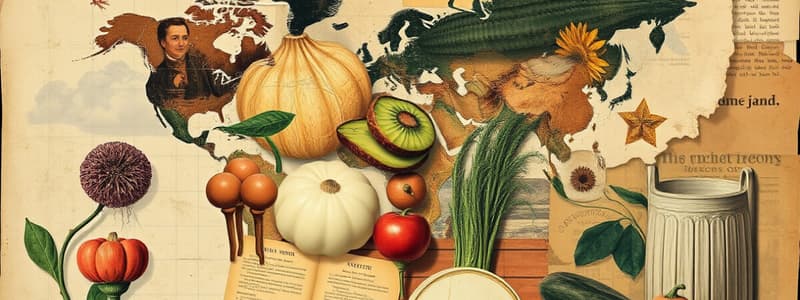Podcast
Questions and Answers
What is Culinary Geography?
What is Culinary Geography?
Foods created during the Great Exchange in Latin America.
Which of the following foods are from the New World? (Select all that apply)
Which of the following foods are from the New World? (Select all that apply)
- Apples
- Avocados (correct)
- Blueberries (correct)
- Artichokes
Which of the following is considered an Old World food?
Which of the following is considered an Old World food?
- Tomatoes
- Cacao
- Chickpeas (correct)
- Coffee
Which of the following nuts are classified as New World foods? (Select all that apply)
Which of the following nuts are classified as New World foods? (Select all that apply)
Which of these foods are associated with the New World? (Select all that apply)
Which of these foods are associated with the New World? (Select all that apply)
Which food is from the Old World?
Which food is from the Old World?
Match the following foods with their origins:
Match the following foods with their origins:
Flashcards are hidden until you start studying
Study Notes
Culinary Geography
- Refers to foods developed during the Great Exchange in Latin America.
- Associated with Colonial Latin America, highlighting the global impact of food distribution.
New World Foods
- Include a variety of fruits, vegetables, and nuts unique to the Americas.
- Notable New World foods:
- Artichokes
- Avocados
- Beans (kidney and Lima), Black Walnuts
- Blueberries, Cacao
- Cashews, Cassava
- Chestnuts, Corn
- Crab Apples, Cranberries
- Gourds, Hickory Nuts
- Onions (both worlds), Papayas
- Peanuts, Pecans
- Peppers, Pineapples
- Plums, Potatoes
- Pumpkins, Raspberries
- Squash, Strawberries
- Sunflowers, Sweet Potatoes
- Tobacco, Tomatoes
- Turkey, Vanilla
- Wild Cherries, Wild Rice
Old World Foods
- Include foods domesticated or cultivated in Europe, Asia, and Africa.
- Significant Old World foods:
- Apples, Bananas
- Beans, Beets
- Broccoli, Carrots
- Cattle, Cauliflower
- Celery, Cheese
- Cherries, Chickens
- Chickpeas, Cinnamon
- Coffee, Cucumbers
- Eggplant, Garlic
- Ginger, Grapes
- Honey (honey bees), Lemons
- Lettuce, Limes
- Mangoes, Oats
- Okra, Olives
- Onions (both worlds), Oranges
- Pasta, Peaches
- Pears, Peas
- Pigs, Radishes
- Rice (not wild), Sheep
- Spinach, Tea
- Watermelon, Wheat, Yams
Key Insights
- Many nuts and berries originated in the New World, contributing significantly to global diets.
- The distinction between Old and New World foods reflects historical trade routes and agricultural developments.
Studying That Suits You
Use AI to generate personalized quizzes and flashcards to suit your learning preferences.





